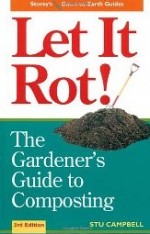 Composting is an ancient activity yet here in the 21st century we are still trying to convince people to do it. More and more gardeners are getting into it but there are still plenty of people to convince that it is a good thing and to hop on the bandwagon and do it. Stu Campbell’s classic book Let it Rot! is an excellent source of friendly information. It is filled with facts and instructions on composting, all presented in a light, humorous and entertaining style that will encourage readers to give it a try.
Composting is an ancient activity yet here in the 21st century we are still trying to convince people to do it. More and more gardeners are getting into it but there are still plenty of people to convince that it is a good thing and to hop on the bandwagon and do it. Stu Campbell’s classic book Let it Rot! is an excellent source of friendly information. It is filled with facts and instructions on composting, all presented in a light, humorous and entertaining style that will encourage readers to give it a try.
Campbell begins by dispelling mystery of composting when he states that “no matter what you do, no matter how many little mistakes you make, you are still probably going to come up with reasonably good, usable compost.” He urges the beginner to start thinking in simple terms and develop more complex techniques as experience teaches. After all, “composting is a way of using up what we have in abundance…”.
The book includes chapters on the history of composting, organisms involved in decomposition, activators to get things going, containers (including construction details), establishing and maintaining the pile, and using the final product. One of the best chapters deals with the nature of compostable material. Campbell discusses all kinds of different wastes from grass clippings to pet poop (not useable) giving the reasons why a waste is suitable or not. Did you know, for example, that grease can coat the fibers of compostable waste and prevent it from breaking down? Understanding the why’s makes learning the facts a lot easier.
Another chapter deals with various kinds of composting methods. Campbell warns the reader not to use any of the descriptions as a definitive model but to adapt and adjust it to fit the situation. The information may be overwhelming to a beginner but can be useful as a source of ideas for the more experienced reader. A chart comparing the advantages and disadvantages of various methods is a quick and easy way to decide the best method for the situation.
The book has numerous drawings to illustrate the points and includes many charts to summarize the information. Interesting facts are included in insets and lists are provided for topics such as materials suitable for the compost pile. Let it Rot! is a good read and a valuable resource on composting.
To buy Let it Rot!: The Gardener’s Guide to Composting from Amazon.com click here.